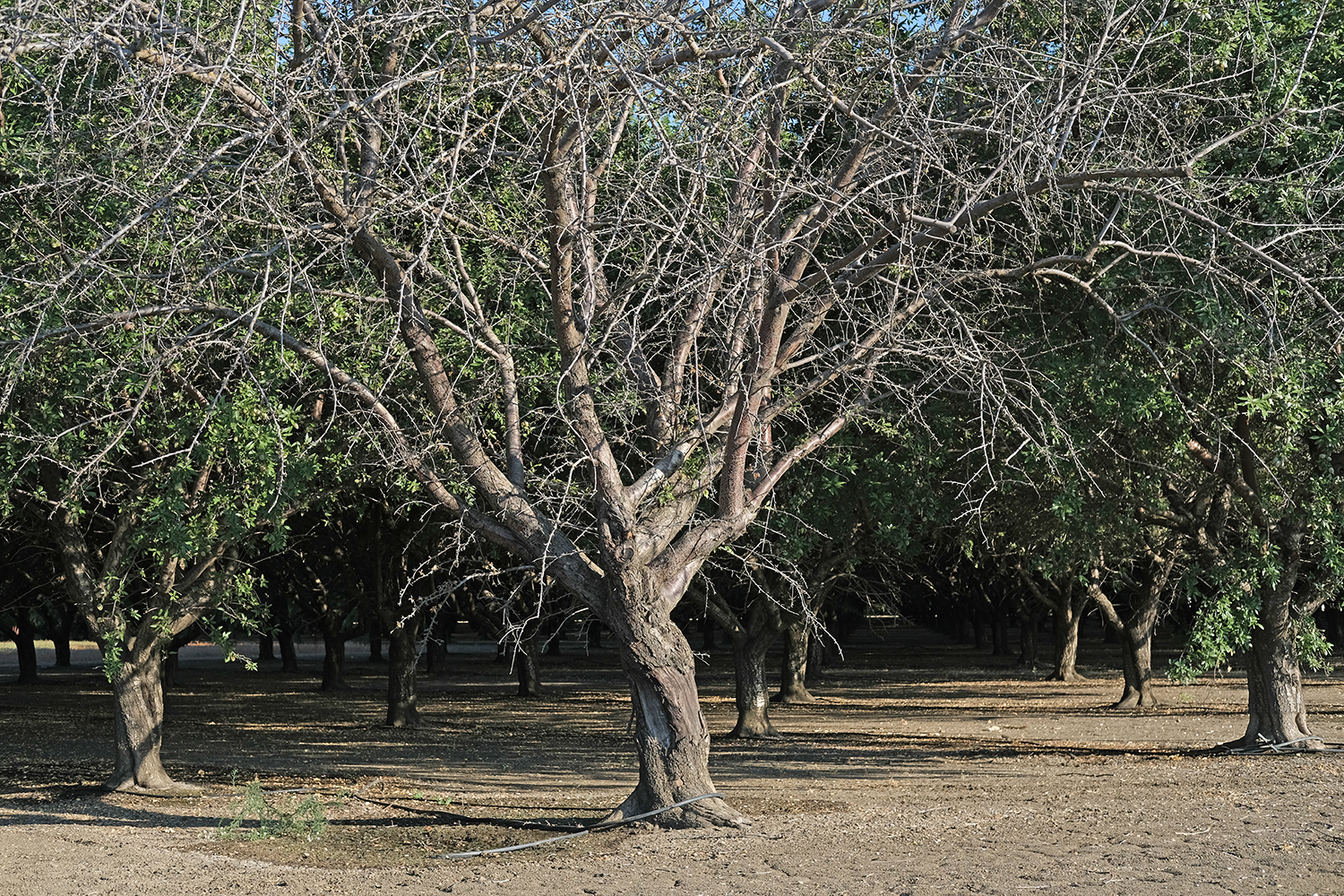Abandoned crops bring pest plague to adjacent farms

Farmers across the Central Valley say neglected orchards are attracting pests that affect neighboring farms.
Photo/Caleb Hampton

By Caleb Hampton
California farmers, agricultural commissioners and lawmakers have in recent months sounded an alarm about a troubling symptom of the state’s struggling farm economy.
“Everywhere you turn there’s an abandoned vineyard,” said Randy Baranek, project manager for the Stanislaus County-based agricultural service provider Fowler Brothers. He estimated there are twice as many untended grapevines in the Central Valley this year than he has ever seen. “It’s a mess.”
It isn’t only vineyards. Tens of thousands of acres of almond orchards have been left unmanaged, according to a 2024 report by Land IQ.
“I don’t remember a year when there were this many abandoned orchards,” said Michael Naito, who grows winegrapes, almonds and pistachios in Fresno and Madera counties. “Guys just don’t have the money to take them out.”
Historically, when an orchard or vineyard neared the end of its productive life, farmers wasted little time replacing it with new trees or vines that would bring them a higher return, Naito said. But with low crop prices plaguing farmers, he said, “that urgency to take out an orchard or vineyard and replant is not there.”
Many winegrape and almond growers have farmed at a loss for consecutive years, depleting cash reserves as input costs such as labor, fuel and fertilizers climbed. Meanwhile, in the San Joaquin Valley, a recent ban on burning discarded agricultural materials has made it more expensive and time-consuming for farmers in the region to dispose of orchards and vineyards.
As a result, a growing number of farmers—unable to afford farming or removal costs—have simply walked away, according to growers and service providers, leaving their trees and vines at the mercy of nature.
The phenomenon has led to widespread concern that pests harbored in abandoned orchards and vineyards could impact adjacent farms.
“When you have a completely abandoned orchard, you tend to have more insect activity,” said Jhalendra Rijal, a University of California Cooperative Extension pest management farm adviser based in Stanislaus County. “It can create problems.”
Navel orangeworm, for example, the most damaging pest in California
almonds, is a moth whose larvae feed on almond kernels and cause fungal infections. Abandoned orchards where no pest control measures are taken can become the perfect breeding ground, farmers said, with consequences for those nearby.
“If there are a lot of moths in one orchard and there is another orchard nearby, you will likely get some moths migrating into that orchard,” Rijal said.
Neighboring one of Naito’s almond orchards is a block of almond trees that has been neither sprayed nor irrigated for the past two to three years, he said. While some trees in the abandoned orchard have died, others are still bearing nuts and attracting pests.
“If you’re right next door, it’s pretty difficult,” Naito said. “You’ve got to spend more because you get a lot of pest pressure.”
Jake Barcellos, who grows almonds and other crops in Fresno and Merced counties, said he has also spent more this year on pest control because of his orchards’ proximity to abandoned almond trees. And bugs aren’t the only problem.
“Rats have become a new thing,” Barcellos said.

Photo/Caleb Hampton
Last fall, rat infestations impacted more than 112,000 acres of almond orchards in the Central Valley, causing an estimated $109.4 million to $310.5 million in damage, according to a memo published this year by the California Department of Food and Agriculture. The rodents gnawed wires in tractors, chewed irrigation lines and damaged trees.
Farmers and industry groups said they suspect the increase in rat damage is connected to the rise in abandoned orchards, which can harbor the rodents.
Farmers cautioned that the situation could get worse before it improves. While almond prices have improved this year, the winegrape market has not. Meanwhile, limits on groundwater pumping under California’s Sustainable Groundwater Management Act have led some growers in parts of the San Joaquin Valley to begin abandoning orchards.
“The fallowing due to SGMA that we’ve all heard about is happening,” Naito said, referring to projections that the landmark groundwater law could force as much as a fifth of the region’s farmland to come out of production within the next 15 years.
To combat the problem, the state may soon give county agricultural commissioners, who are tasked with cleaning up neglected orchards and vineyards, a new tool to incentivize cooperation from landowners.
Current state law allows agricultural commissioners to place liens on abandoned properties that have been declared a nuisance and in which property owners have failed to address after a warning. But the abatement process can take years, and it weighs on county budgets, as counties must pay to remove crops or control pests before trying to recoup the money by placing a lien on the property.
“The current abatement procedures place a cost-prohibitive burden on the counties,” Fresno County Agricultural Commissioner Melissa Cregan said this year during a state Assembly hearing. In one instance, a pension fund purchased and then abandoned 7,000 acres of orchards and vineyards in Fresno County, Cregan said, estimating it would have cost at least $14 million to remove the trees and vines. “Local governments simply do not have the funds to front these costs,” she said.
Assembly Bill 732, authored by Alexandra Macedo, R-Tulare, would allow agricultural commissioners to fine landowners $500 per acre if they fail to make a good faith effort to address a pest-related public nuisance within 30 days and $1,000 per acre if they do not take action within 45 days. The bill has bipartisan support and is backed by numerous industry groups, including the California Farm Bureau.
“This process is something that we unfortunately need,” Macedo said. “We’re not trying to come in and be a bully. We’re coming in and trying to work with ag to solve a problem.”
Caleb Hampton is assistant editor of Ag Alert. He can be reached at champton@cfbf.com.




